Methylene blue is a fascinating compound, not just because of its vibrant color! It’s known for potential health benefits like boosting cognitive function and fighting infections. However, you must tread carefully—talk to a healthcare professional first, especially since it can interact with other medications. You might notice some side effects, like a blue tint to your urine! Curious about how to fit this into your routine and what research is on the horizon? There's plenty more to discover!
Key Takeaways
- Methylene blue enhances cellular energy production and improves oxygen utilization, benefiting overall health and cognitive function.
- It possesses antimicrobial properties and may help reduce anxiety and enhance mood.
- Consultation with a healthcare professional is crucial before starting methylene blue to ensure safety and monitor for side effects.
- Common side effects include blue urine discoloration, mild headaches, and gastrointestinal upset; awareness of rare reactions is also essential.
- Ongoing research explores methylene blue's potential in neuroprotection and treating neurodegenerative diseases like Alzheimer's and Parkinson's.
What Is Methylene Blue?
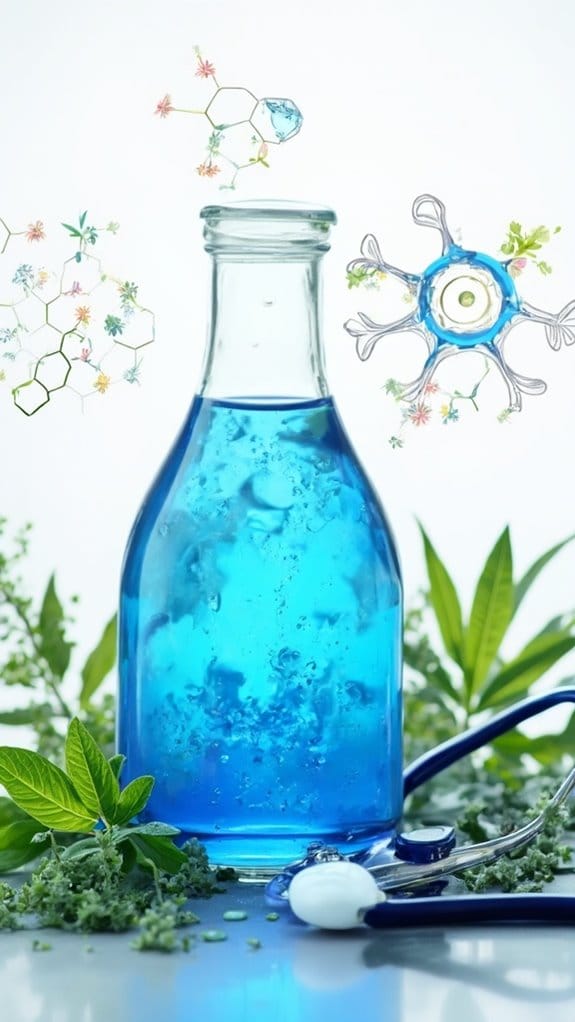
Methylene blue might sound like something straight out of a science fiction movie, but it's a fascinating compound with a rich history in medicine. You might be surprised to learn that this vibrant blue dye has been around since the late 19th century, initially used as a textile dye.
Over time, its applications have evolved considerably. Today, methylene blue is celebrated for its role in various medical fields, from treating methemoglobinemia to enhancing cellular energy production.
When you dig deeper into methylene blue history, you'll discover it’s more than just a dye; it's a symbol of innovation in healthcare. Imagine a compound that not only colors but also holds the potential to improve your well-being!
Historical Uses of Methylene Blue in Medicine
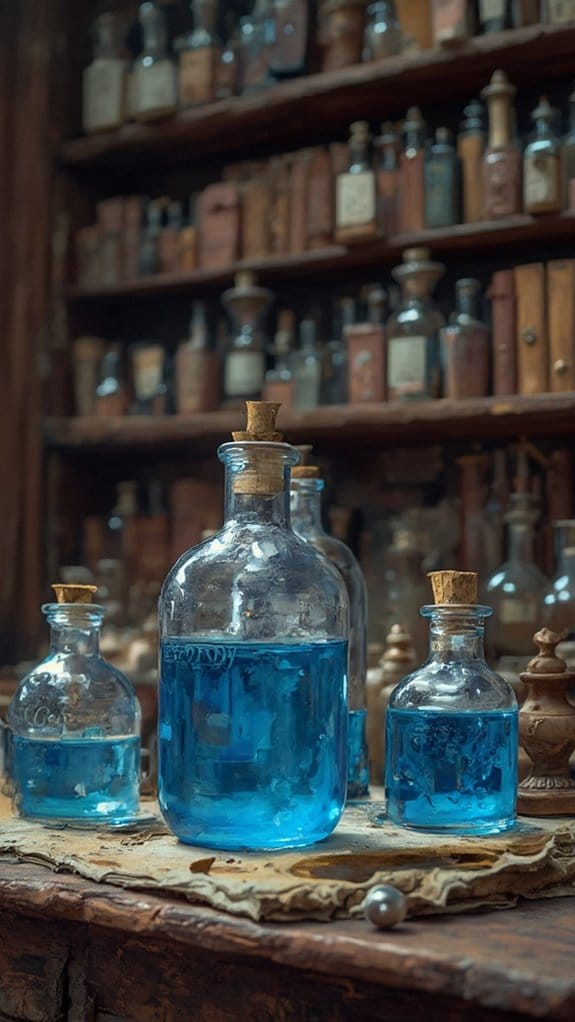
Methylene blue has quite the history in medicine, hasn't it? You might be surprised to learn that it was once a go-to treatment for malaria and even served as a surgical staining agent. Plus, it helped doctors make vital diagnoses, proving that this vibrant dye has played more roles in healthcare than you might expect!
Early Antimalarial Treatment
Back in the early 20th century, when malaria was a widespread and deadly disease, scientists turned to a surprising solution: a bright blue dye known for its color more than its medicinal properties.
Methylene blue emerged as an early antimalarial treatment, showcasing intriguing effectiveness when used for the disease. Its unique properties allowed for early diagnosis and improved treatment efficacy.
- It offered a vibrant alternative to traditional remedies.
- Many patients experienced quicker recoveries.
- Doctors embraced this innovative approach in the fight against malaria.
Isn't it fascinating how something as simple as a dye played a role in saving lives? Methylene blue wasn’t just a pretty color; it marked a pivotal moment in medical history, embracing the spirit of exploration and freedom in healthcare.
Surgical Staining Agent
In the world of surgery, precision is everything, and that’s where a vibrant blue dye comes into play. Methylene blue isn’t just any dye; it’s a powerful surgical staining agent that helps surgeons identify and differentiate tissues during procedures.
Think about it—how essential is it to see exactly what you’re working with when every cut counts? With its clinical applications, this dye enhances visibility, making complex surgeries a bit less intimidating. It’s used in various procedures, from marking lymph nodes to highlighting certain tissues, ensuring that surgeons can operate with confidence.
Diagnostic Tool Usage
While you might know methylene blue primarily for its vibrant hue in surgical settings, its journey as a diagnostic tool in medicine is equally fascinating. This compound isn’t just eye-catching; it has significant diagnostic applications that have stood the test of time.
- It helps identify certain infections, thanks to its ability to stain bacteria.
- It plays a role in evaluating oxygen levels in blood, aiding in respiratory diagnostics.
- Its clinical significance extends to assessing conditions like methemoglobinemia, where it effectively restores normal blood function.
Isn’t it amazing how one substance can serve multiple roles? From surgery to diagnostics, methylene blue continues to prove its worth.
Mechanism of Action: How Methylene Blue Works

When you think about how Methylene Blue works, it's pretty fascinating to contemplate its role in the body. This compound has a unique mechanism that primarily involves its ability to act as an electron donor in cellular respiration. Fundamentally, it can help your cells produce energy more efficiently.
You might be wondering about its methylene blue applications—well, they range from treating certain medical conditions to enhancing cognitive function. Methylene blue benefits include its potential to improve oxygen utilization in tissues, which could lead to better overall health. It’s like giving your cells a little boost so they can perform at their best.
Plus, Methylene Blue's ability to cross the blood-brain barrier makes it even more intriguing for those looking to support brain health. So, whether you’re curious about its historical uses or modern applications, Methylene Blue is certainly worth exploring!
Potential Health Benefits of Methylene Blue
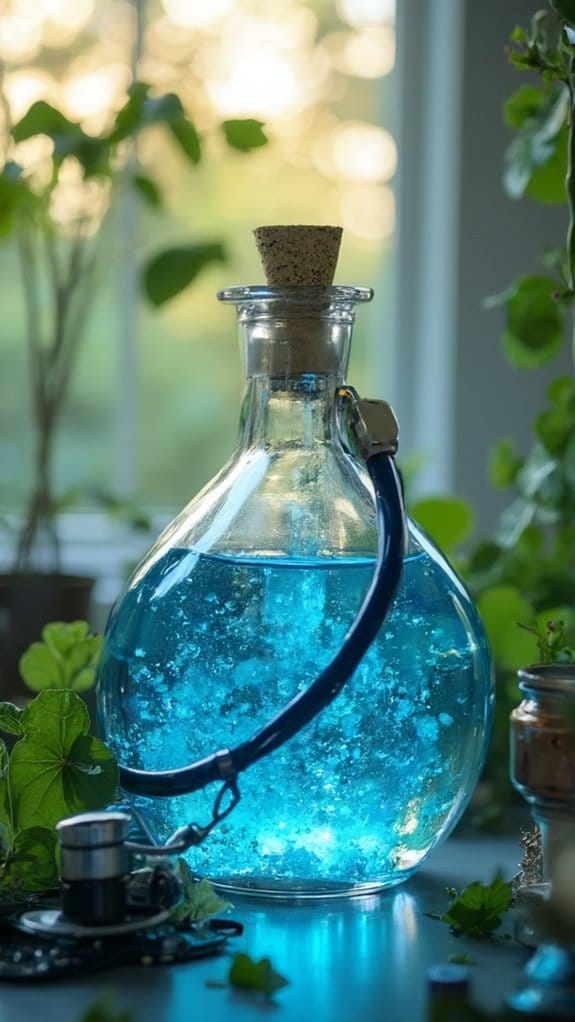
Methylene Blue isn’t just a fascinating compound; it might also offer a variety of health benefits that could catch your interest. Its history dates back to its use as a dye, but research suggests it may have more to offer.
Here are some potential benefits you might want to explore:
- Antimicrobial properties: It could help fight certain infections.
- Mood enhancement: Some studies hint at its ability to boost mood and combat anxiety.
- Cellular protection: Methylene Blue may protect your cells from oxidative stress.
Of course, it’s important to keep in mind the potential risks associated with its use. Always consult a healthcare professional before diving in. With its intriguing background, methylene blue could be worth considering for your health journey. Are you ready to discover what this compound might do for you?
Methylene Blue and Cognitive Enhancement

Many people are curious about how certain substances can boost brain power, and methylene blue has popped up on the radar for its potential cognitive enhancement abilities. You might be wondering how this vibrant blue dye could help your brain.
Well, some research suggests that methylene blue could improve cognitive function and even aid in memory enhancement. It’s believed to increase energy production in brain cells, which may help you think clearly and remember things better. Imagine breezing through your studies or recalling details without a hitch!
But here’s the catch: while the promise sounds exciting, it’s essential to approach methylene blue with caution. Like any substance, it’s not a magic bullet, and individual responses can vary.
Antioxidant Properties of Methylene Blue
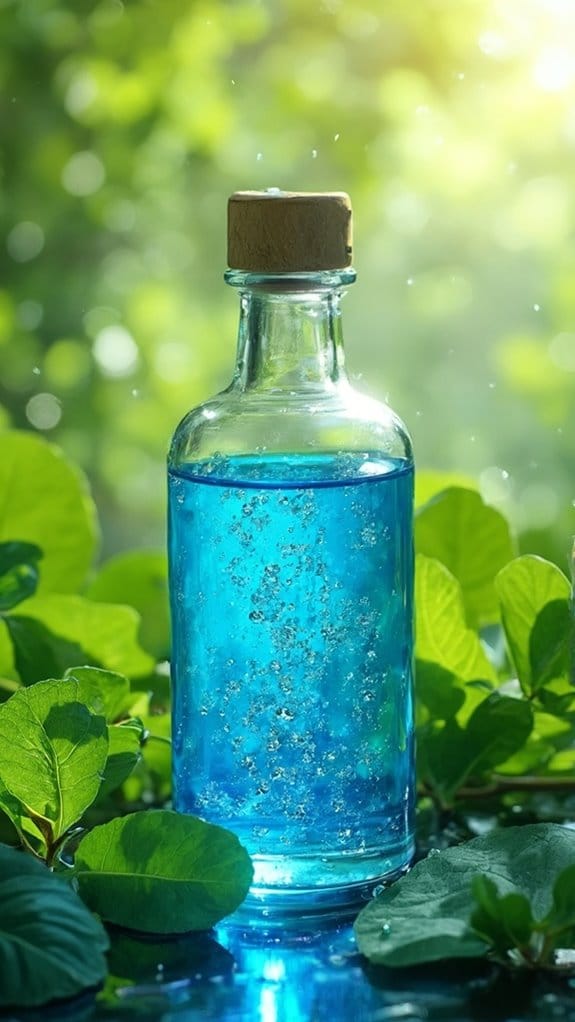
When you think about antioxidants, how does methylene blue stack up against the rest? This vibrant compound not only showcases a unique mechanism of action but also has some interesting comparisons with other well-known antioxidants. Plus, there are clinical studies that shed light on its potential benefits, making it a topic worth exploring further!
Mechanism of Action
Revealing the secrets of how substances like methylene blue work can be pretty fascinating! Methylene blue acts as a powerful antioxidant, stepping in to protect your cells during stressful times. It supports cellular respiration, helping your body convert nutrients into energy more efficiently. This process not only boosts your liveliness but also keeps harmful free radicals in check.
Here are a few cool things about its mechanism:
- It reduces oxidative stress in cells, promoting better health.
- Methylene blue can enhance mitochondrial function, which is essential for energy production.
- It may even improve cognitive function by protecting brain cells!
Comparison With Other Antioxidants
While there are plenty of antioxidants out there, methylene blue stands out for its unique properties and benefits. When comparing it to other popular options, you might wonder how it measures up. Check out the table below for a quick snapshot:
| Antioxidant | Antioxidant Effectiveness | Methylene Blue Alternatives |
|---|---|---|
| Vitamin C | High | Glutathione |
| Vitamin E | Moderate | Alpha-Lipoic Acid |
| CoQ10 | High | Resveratrol |
| Methylene Blue | Exceptional | N-acetylcysteine |
| Curcumin | Moderate | Quercetin |
Methylene blue not only offers remarkable antioxidant effectiveness but also provides unique cellular benefits that many alternatives can’t match. So, are you ready to explore this powerful compound?
Clinical Studies Overview
Methylene blue's impressive antioxidant properties have caught the attention of researchers, leading to various clinical studies that explore its effectiveness.
These studies often focus on different clinical trial designs, aiming to assess methylene blue efficacy in various conditions.
- Some trials target neurodegenerative diseases, evaluating how it combats oxidative stress.
- Others examine its potential in improving cognitive function, sparking interest in memory enhancement.
- A few studies investigate its use in treating infections, showcasing its versatility.
As you consider these findings, you might wonder how this unique compound could benefit you. The ongoing research hints at a promising future, but the journey to fully understand methylene blue’s capabilities has just begun.
Are you ready to explore its potential?
Role of Methylene Blue in Treating Neurodegenerative Diseases

Imagine a world where a simple blue dye could hold the key to slowing down the effects of neurodegenerative diseases like Alzheimer's and Parkinson's. Methylene blue might just be that breakthrough!
It works through various neuroprotection mechanisms, helping to shield your brain cells from damage. By enhancing cellular metabolism, it boosts energy production in your neurons, keeping them active and alive longer.
Methylene blue enhances cellular metabolism, energizing neurons and protecting brain cells from damage for a healthier mind.
You might wonder, how does it work? Well, methylene blue acts like a superhero, improving mitochondrial function and reducing oxidative stress. This means your brain can fight back against those pesky degenerative changes.
While research is still unfolding, the potential benefits are exciting. So, if you’re looking for ways to support your brain health, keep an eye on this fascinating dye. After all, who wouldn’t want a little extra help in maintaining mental clarity and independence as they age?
Methylene Blue as an Antimicrobial Agent
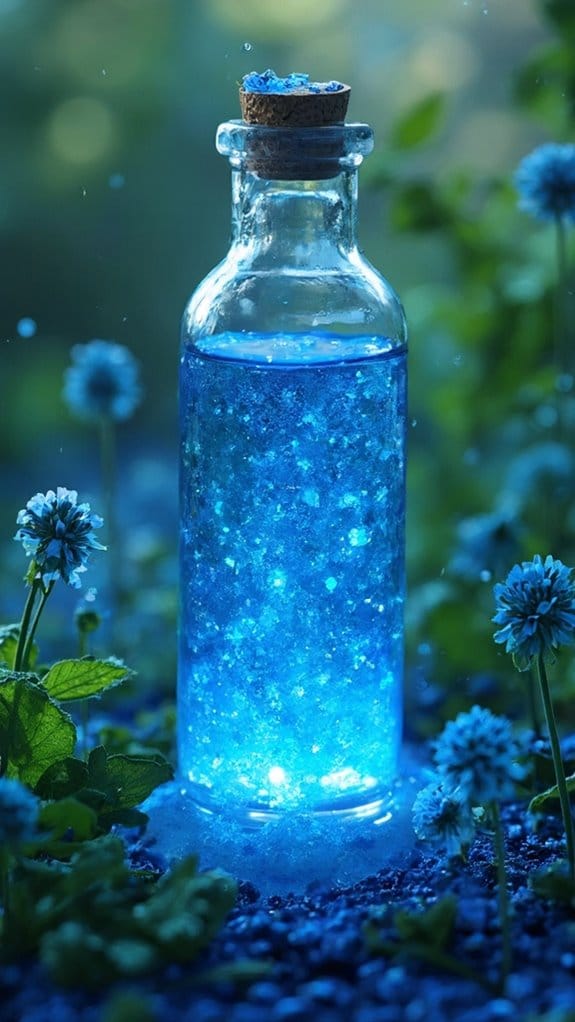
Have you ever wondered how a simple dye could pack a punch against harmful germs? Methylene blue acts as an antimicrobial agent, targeting bacteria and other pathogens with impressive efficacy. As we explore its mechanism of action, clinical applications, and safety considerations, you might just find this little blue compound more fascinating than you expected!
Mechanism of Action
When it comes to the fascinating world of antimicrobial agents, methylene blue stands out with a unique mechanism of action that’s worth exploring. This vibrant compound does more than just color your lab slides; it actively fights bacteria and fungi. Here’s how it works:
- Disruption of microbial membranes: Methylene blue penetrates bacterial cells, weakening their defenses.
- Generation of reactive oxygen species: It triggers oxidative stress in pathogens, leading to their downfall.
- Enhanced immune response: This agent can boost your body’s natural defenses, making it a powerful ally.
When considering methylene blue applications, always remember to follow safety protocols. After all, knowledge is freedom, and being informed guarantees you make the best choices for your health!
Clinical Applications
While you might think of methylene blue primarily as a dye, its clinical applications as an antimicrobial agent are truly impressive. This vibrant compound has shown potential in fighting off various infections, making it a fascinating option for therapeutic uses. In recent clinical trials, researchers found that methylene blue can effectively tackle certain bacteria and even some viruses.
Imagine having a powerful ally in your quest for better health! Its unique properties allow it to disrupt microbial processes, giving your immune system a fighting chance. So, if you’re seeking alternatives to conventional treatments, methylene blue might be worth exploring. Just remember, the health journey is personal, and every option deserves careful consideration.
What'll you discover next?
Safety Considerations
As you explore the potential of methylene blue as an antimicrobial agent, it’s important to evaluate its safety profile. While this compound shows promise, taking the right methylene blue dosage is vital to avoid unwanted side effects.
Here are some safety precautions to keep in mind:
- Always consult a healthcare professional before starting any new treatment.
- Monitor for allergic reactions or adverse effects, especially if you have pre-existing conditions.
- Stick to recommended dosages to guarantee safe usage.
With the right approach, you can enjoy the benefits of methylene blue while minimizing risks. Remember, your health is your freedom, and staying informed empowers you to make the best choices!
Safety Considerations When Using Methylene Blue
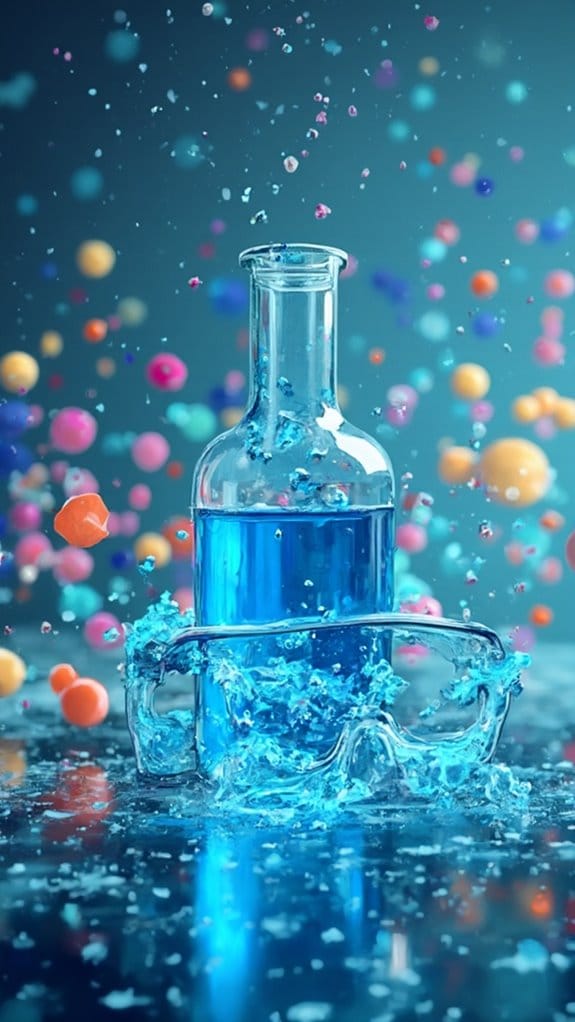
Before diving into the benefits of methylene blue, it’s essential to contemplate its safety. You want to guarantee you're using it responsibly, right? Understanding methylene blue precautions can help you avoid potential pitfalls. Always stick to established usage guidelines to keep things in check.
Here's a quick overview of key safety points:
| Consideration | Details |
|---|---|
| Medical Conditions | Consult a doctor if you have any health issues. |
| Drug Interactions | Be aware of medications that may interact. |
| Allergies | Check for any potential allergic reactions. |
Dosage Guidelines for Methylene Blue
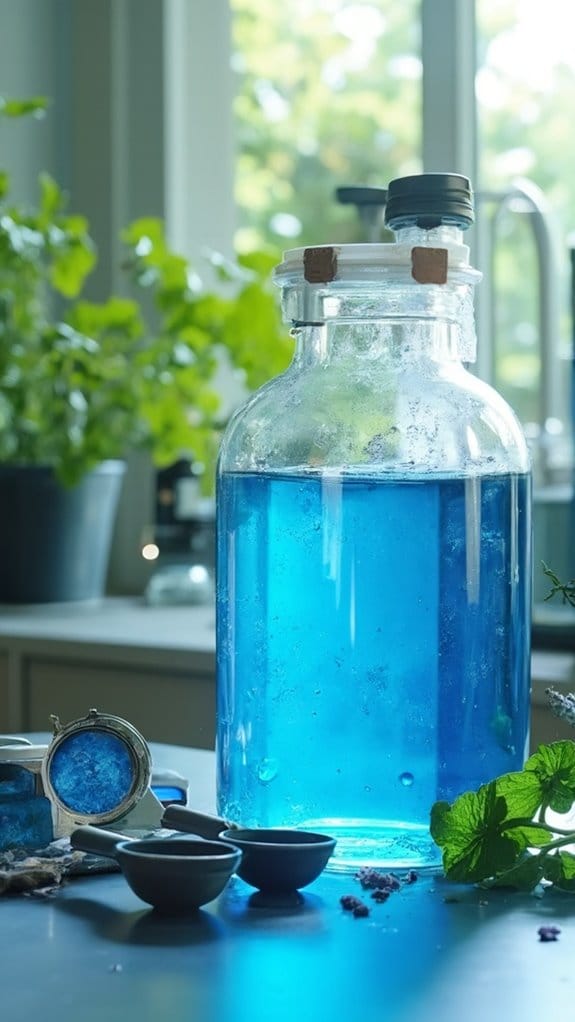
You've got the safety considerations in mind, so let’s talk about how to use methylene blue effectively. Getting the right dosage is essential, and it typically comes in various dosage forms, like tablets or liquids. Depending on what you're using it for, the dosage frequency can vary.
Here are a few key points to keep in mind:
- Start low and go slow: Begin with a lower dose to see how your body reacts.
- Consult a professional: Always check with a healthcare provider to tailor the dosage to your needs.
- Monitor your progress: Keep an eye on how you feel, adjusting as necessary.
Possible Side Effects of Methylene Blue

While methylene blue has its benefits, it’s essential to contemplate the possible side effects you might encounter. You could experience common issues like headaches or dizziness, but there are also rare adverse reactions that could surprise you.
Common Side Effects
When considering the use of methylene blue, it’s important to be aware of the possible side effects that might arise. While many people may benefit from it, there are some methylene blue risks you should know.
Here are a few common side effects you could experience:
- Blue or green discoloration of urine or skin
- Mild headaches
- Gastrointestinal upset
These effects can vary depending on the dosage recommendations you follow, so always consult with a healthcare professional before starting. It's essential to listen to your body and stay informed. Remember, awareness is key, and knowing what to expect can help you navigate your journey with methylene blue more smoothly.
Are you ready to take the plunge?
Rare Adverse Reactions
Although most people tolerate methylene blue well, some rare adverse reactions can occur that you mightn't expect. While infrequent side effects are generally mild, you should stay aware. Some individuals may experience rare allergic reactions, which can manifest as rashes, itching, or even swelling. It’s essential to pay attention to your body—if something feels off, don’t hesitate to consult a healthcare professional.
You might wonder, “Is it worth the risk?” Most users find the benefits outweigh these rare occurrences. Just remember, everyone’s body is different, and what works for one person mightn't for another. So, keep your eyes open and trust your instincts; that’s your best guide on this journey!
Interactions With Other Medications
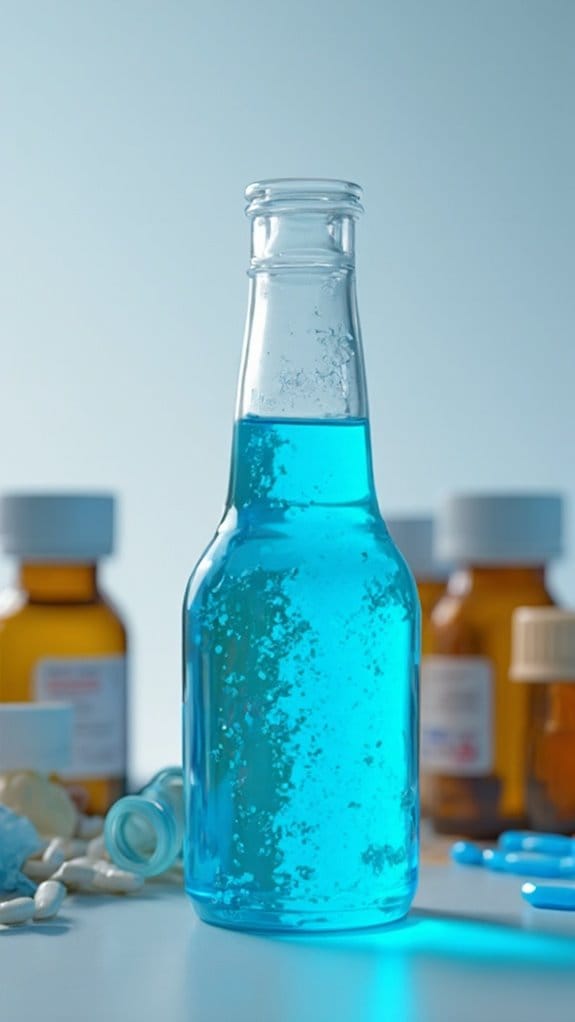
Methylene blue can be a powerful tool for certain health benefits, but it’s important to evaluate how it interacts with other medications you might be taking. Drug interactions can lead to contraindications effects, which can complicate your treatment plan. So, before you plunge into using methylene blue, consider these points:
Drug interactions can complicate your treatment plan, so evaluate potential contraindications before using methylene blue.
- Check for Antidepressants: Some antidepressants may not play nice with methylene blue, increasing the risk of serotonin syndrome.
- Blood Thinners Alert: If you're on blood thinners, be cautious; methylene blue can affect how these meds work.
- Consult Your Doctor: Always chat with your healthcare provider to assess potential drug interactions and guarantee your safety.
Methylene Blue in Research: Current Studies

As research into health treatments evolves, it’s exciting to see scientists exploring the potential of methylene blue beyond its traditional uses. You're probably wondering what makes this compound so intriguing, right?
Researchers are diving into various methylene blue applications, from its role in enhancing mitochondrial function to its potential in neuroprotection. These studies are uncovering fascinating methylene blue mechanisms that may help combat conditions like Alzheimer’s and certain cancers.
Imagine a world where a simple dye could support your brain health! Current studies are examining its ability to reduce oxidative stress and improve cellular energy production. This could be a game-changer for those seeking freedom from debilitating diseases. As this research unfolds, you're invited to stay curious and consider how these findings might impact your health journey. After all, knowledge is power, and who wouldn't want to harness that for a healthier future?
How to Incorporate Methylene Blue Into Your Routine
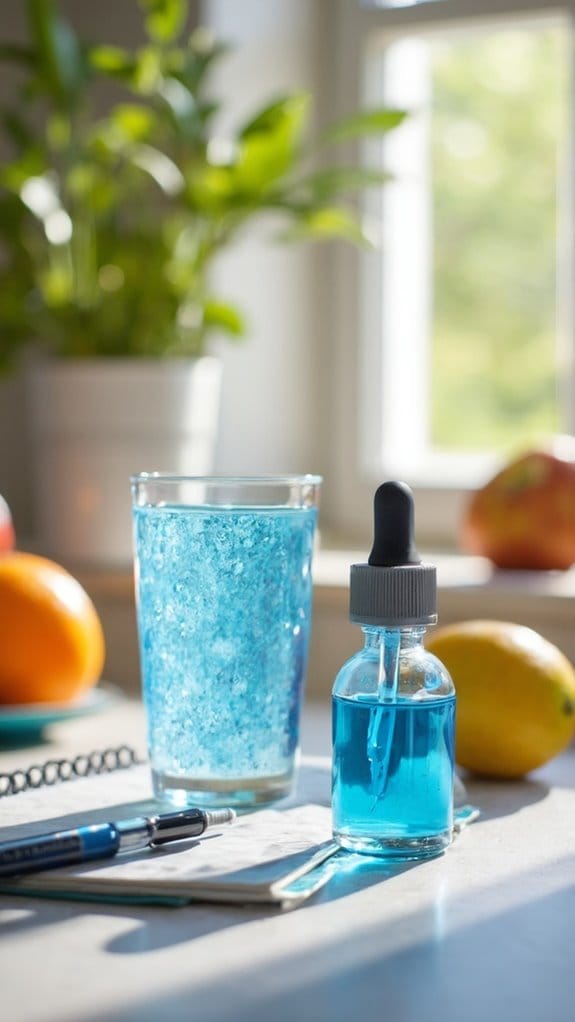
If you're intrigued by the potential benefits of methylene blue, you might be wondering how to make it a part of your daily routine. Incorporating this compound into your life can be straightforward and rewarding. Here’s how to get started:
- Choose your method: Whether you prefer capsules, liquid, or powder, pick a form that fits your lifestyle.
- Mind the daily dosage: Start with a low dose to see how your body reacts. Gradually adjust as needed, keeping safety in mind.
- Integrate it into your regimen: Add it to your morning smoothie or take it with your vitamins—it’s all about finding what works for you!
Experimenting with methylene blue applications can lead to exciting discoveries about your health. Just remember to stay informed and listen to your body.
Are you ready to embrace this colorful addition to your wellness journey?
Future Directions for Methylene Blue Research

While the exploration of methylene blue's benefits has gained traction, there's still so much more to uncover about this intriguing compound. You might wonder what future applications could spark excitement in the research community. Imagine the potential for methylene blue in treating neurodegenerative diseases or enhancing cellular energy production!
However, it’s not all smooth sailing; there are significant research challenges we must tackle. For instance, understanding its long-term effects and ideal dosages requires a thorough investigation. Researchers face hurdles like regulatory approvals and the need for extensive clinical trials, but that shouldn't deter anyone. It’s essential to keep pushing boundaries.
Frequently Asked Questions
Is Methylene Blue Safe for Pets?
Is methylene blue safe for pets? Well, it’s a bit tricky.
While it’s used in some pet treatments, you’ve got to watch out for methylene blue toxicity. The dosage matters, and not every pet reacts the same way. If you’re considering it, consult your vet first. They’ll help you weigh the benefits and risks.
After all, you want your furry friend to be happy and healthy, right? Better safe than sorry!
Can Methylene Blue Be Used During Pregnancy?
You might be wondering if methylene blue is safe during pregnancy.
While some studies suggest its use, caution is key. The methylene blue dosage can vary, and its effects on a developing fetus aren’t fully understood. It's always best to consult your healthcare provider before considering it. After all, you want to guarantee both your safety and your baby’s well-being, right?
What Is the Shelf Life of Methylene Blue?
Imagine a trusty old book sitting on your shelf, its pages yellowing over time.
Methylene blue’s shelf life is about two years if you store it properly. Keep it in a cool, dark place away from moisture. Think of it like a delicate flower needing the right conditions to bloom.
If you follow these storage conditions, you’ll guarantee its shelf stability, allowing you to enjoy its benefits for as long as possible!
Are There Alternatives to Methylene Blue?
Looking for methylene blue alternatives? You’ve got options!
Natural remedies like turmeric and ginger offer anti-inflammatory benefits, while activated charcoal can aid in detoxification. Ever tried essential oils? They’re great for various issues, too! It’s all about finding what works for you. Remember, though, not every alternative suits everyone.
How Does Methylene Blue Affect Kidney Function?
Imagine your kidneys as the diligent gatekeepers of your body, tirelessly filtering out the bad while keeping the good. When it comes to methylene blue, its effects on kidney health can be a mixed bag. While some research hints at potential protective benefits, excessive use might strain these essential organs.
Conclusion
In wrapping up, it's clear that methylene blue offers some intriguing possibilities for health and wellness. While it might sound like a magical potion, remember, it’s not without its quirks and complications. So, if you’re curious about adding it to your routine, just tread carefully and consult with a healthcare pro first. After all, a little caution goes a long way in the world of wellness, doesn’t it? Here’s to exploring new frontiers, safely!
